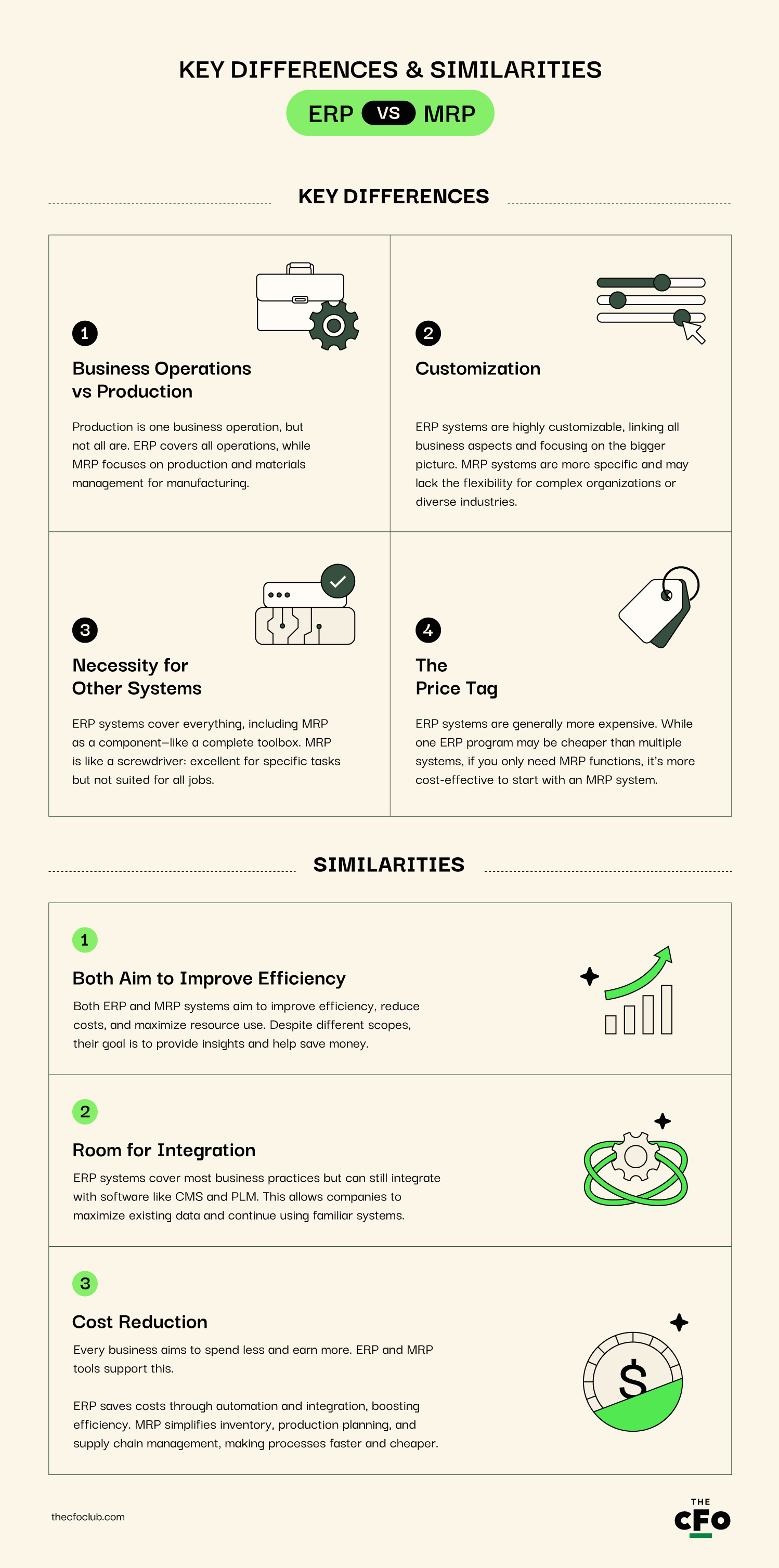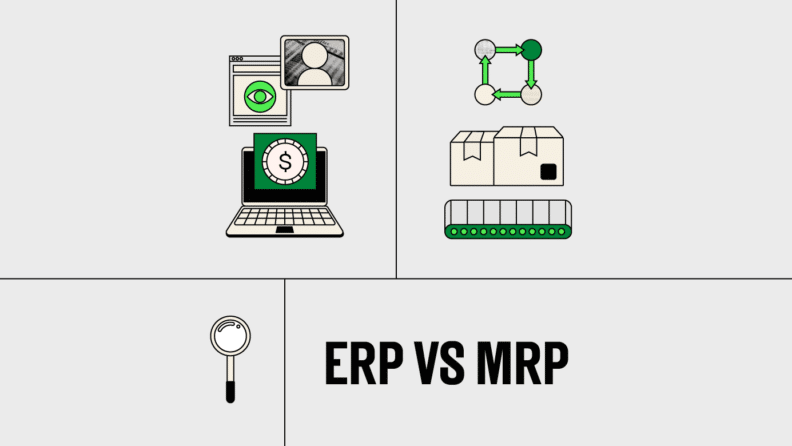ERP vs MRP: More than just a fat-fingered typo.
Enterprise resource planning and material requirements planning are two separate processes with their own dedicated systems. Here’s what you need to know:
What Are ERP Systems?
ERP (short for Enterprise Resource Planning) systems are huge, comprehensive tools, integrating various company activities such as human resources, finance, customer relationship management, and supply chain management into a single platform.
Some of the best ERP systems out there are:
- SAP ERP: Developed by SAP, this tool is one of the most widely used ERP solutions globally, offering modules for finance, logistics, human resources, and more.
- Oracle ERP Cloud: Oracle offers a suite of cloud-based ERP applications that cover finance, procurement, project management, and other business functions.
- Microsoft Dynamics 365 Finance: Part of the Microsoft Dynamics 365 suite, Dynamics 365 Finance provides comprehensive financial management capabilities, including budgeting, forecasting, and financial reporting.
What Are MRP Systems?
Material Requirements Planning (MRP) systems are a bit more limited in scope, primarily being used by manufacturing businesses to plan and manage their production process.
MRP systems focus on:
- Managing stock,
- Inventory control,
- Monitoring work in progress products,
- Capacity planning,
- Manufacturing.
At its core, MRP calculates the materials needed for production based on factors such as current inventory levels, sales orders, and production schedules.
The overall process implemented by MRP Solutions includes:
- Inventory Management: First, the MRP tool analyzes current inventory levels of raw materials and components and compares those levels to the requirements for upcoming production orders and sales demands.
- Bill of Materials (BOM): MRP relies on what we call a bill of materials, which is a list of all the components and quantities needed to produce a finished product. By referencing the BOM, the system determines the materials required for each item in the production schedule.
- Demand Forecasting: MRP analyzes customer orders to predict future demand for finished goods. This helps businesses ensure they have the necessary materials on hand to meet customer needs without over- or under-stocking.
- Production Scheduling: Once the materials requirements are calculated, MRP generates a production schedule based on factors such as lead times, production capacity, and order priorities. This schedule helps optimize production efficiency and meet delivery deadlines.
- Procurement Planning: MRP also assists in procurement planning by generating purchase orders for the materials needed to fulfill production requirements. It considers factors like vendor lead times and minimum order quantities to ensure timely delivery of materials.
ERP vs MRP: Key Differences & Similarities
ERP and MRP systems focus on different business processes, which leads to them having different features.
Here’s a breakdown of the key differences and similarities between ERP and MRP:
| Differences | Similarities | ||
| ERP | MRP | ||
| Purpose | ERPs optimize business operations across different departments. | MRPs optimize manufacturing operations. | They both focus on optimization, just on a different scale. |
| Responsibilities | ERP tools look at all the departments, from HR and customer service to sales and marketing. | MRP tools focus solely on manufacturing and production tasks. | They both offer integrations to manage their responsibilities more efficiently. |
| Techniques | Data-driven management across all operations. | Material requirements planning for production. | Both focus on efficient decision-making through data. |
| Tools | SAP, Oracle, JD Edwards, and Visibility. | Fishbowl, Infor, StartProto, MRPeasy. | Both focus on unifying business processes and data management |
| KPIs | Overall business performance metrics. | Production efficiency, inventory turnover, lead times. | ERP reports on all areas covered by MRP. |
Key Differences
Business Operations vs Production
Production is a business operation, but not all business ops are production. ERP is a larger-scale system, that looks at all business ops, whereas MRP focuses specifically on managing production processes and materials management for manufacturing work.
Customization
ERP systems tend to be more customizable, as they look to reach out and link all aspects of your business. When building your ERP system, you tend to look at the bigger picture and make decisions from that point of view.
On the other hand, MRP systems are more specific and may lack the flexibility required for complex organizational structures or diverse industries.
Necessity for Other Systems
ERP systems look to cover everything—in fact, MRP is usually one of the components within an ERP system. It's like buying a toolbox that’s already full.
MRP, however, is like a screwdriver: Great for the task in front of it, but shouldn’t be used for nailing something in.
The Price Tag
In case you haven’t guessed already, you’re going to be paying a lot more for ERP systems, on average.
When you look at the cost of access to a bunch of systems, one ERP program will be cheaper; however, if you only need it for the tasks an MRP system covers, you ought to save your pennies and start small.
Similarities Between Systems
Both Aim to Improve Efficiency
Both ERP and MRP systems are designed to improve operational efficiency by optimizing processes, minimizing costs, and maximizing resource utilization. While their scope may differ, their ultimate goal is the same: Give insights and help you save money.
Room for Integration
Even though ERP covers most standard business practices, it can still be integrated with other software solutions such as CMS and PLM.
This helps companies make the most out of their existing data and stick to those systems they are familiar with.
Cost Reduction
Every business shares a common goal: Spend less money to make more money. As you might expect, both of these tools help bring you closer to that aim.
ERP systems offer cost savings through automation and integration, leading to company-wide efficiency and productivity increases. MRP software makes managing inventory, planning production, and overseeing your supply chain easier; ergo, faster and therefore, less expensive.

Is ERP Or MRP More Valuable?
The value of ERP or MRP will depend on different factors such as:
- Company size
- Industry
- Complexity
- Long term goals
If your goals are more limited to manufacturing operations, you’ll find the reduced cost and quicker implementation timeline of MRP software to be preferable; however, if you’re ready to overhaul your whole business’s operations, ERP is the clear winner.
Subscribe for More Financial Management Insights
If you want to organize your company’s finances, I want to help you. Whether you’re deciding between other software options or looking for the best way to build out your accounting department, I have you covered.
Ready to compound your abilities as a finance leader? Subscribe to our free newsletter for expert advice, guides, and insights from finance leaders shaping the tech industry.



